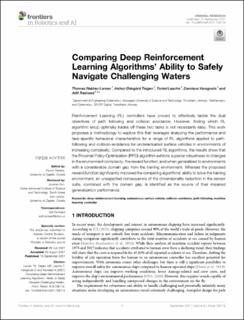| dc.contributor.author | Larsen, Thomas Nakken | |
| dc.contributor.author | Teigen, Halvor Ødegård | |
| dc.contributor.author | Laache, Torkel | |
| dc.contributor.author | Varagnolo, Damiano | |
| dc.contributor.author | Rasheed, Adil | |
| dc.date.accessioned | 2022-05-06T11:19:34Z | |
| dc.date.available | 2022-05-06T11:19:34Z | |
| dc.date.created | 2021-09-03T09:18:33Z | |
| dc.date.issued | 2021 | |
| dc.identifier.citation | Frontiers in Robotics and AI. 2021, 8, 738113. | en_US |
| dc.identifier.issn | 2296-9144 | |
| dc.identifier.uri | https://hdl.handle.net/11250/2994547 | |
| dc.description.abstract | Reinforcement Learning (RL) controllers have proved to effectively tackle the dual objectives of path following and collision avoidance. However, finding which RL algorithm setup optimally trades off these two tasks is not necessarily easy. This work proposes a methodology to explore this that leverages analyzing the performance and task-specific behavioral characteristics for a range of RL algorithms applied to path-following and collision-avoidance for underactuated surface vehicles in environments of increasing complexity. Compared to the introduced RL algorithms, the results show that the Proximal Policy Optimization (PPO) algorithm exhibits superior robustness to changes in the environment complexity, the reward function, and when generalized to environments with a considerable domain gap from the training environment. Whereas the proposed reward function significantly improves the competing algorithms’ ability to solve the training environment, an unexpected consequence of the dimensionality reduction in the sensor suite, combined with the domain gap, is identified as the source of their impaired generalization performance. | en_US |
| dc.language.iso | eng | en_US |
| dc.publisher | Frontiers | en_US |
| dc.rights | Navngivelse 4.0 Internasjonal | * |
| dc.rights.uri | http://creativecommons.org/licenses/by/4.0/deed.no | * |
| dc.subject | Deep reinforcement learning | en_US |
| dc.subject | Autonomous surface vehicle | en_US |
| dc.subject | Collision avoidance | en_US |
| dc.subject | Path following | en_US |
| dc.subject | Machine learning controller | en_US |
| dc.title | Comparing Deep Reinforcement Learning Algorithms’ Ability to Safely Navigate Challenging Waters | en_US |
| dc.type | Peer reviewed | en_US |
| dc.type | Journal article | en_US |
| dc.description.version | publishedVersion | en_US |
| dc.rights.holder | © 2021 Larsen, Teigen, Laache, Varagnolo and Rasheed. This is an open-access article distributed under the terms of the Creative Commons Attribution License (CC BY). The use, distribution or reproduction in other forums is permitted, provided the original author(s) and the copyright owner(s) are credited and that the original publication in this journal is cited, in accordance with accepted academic practice. No use, distribution or reproduction is permitted which does not comply with these terms. | en_US |
| dc.source.pagenumber | 19 | en_US |
| dc.source.volume | 8 | en_US |
| dc.source.journal | Frontiers in Robotics and AI | en_US |
| dc.identifier.doi | 10.3389/frobt.2021.738113 | |
| dc.identifier.cristin | 1931036 | |
| dc.relation.project | Norges forskningsråd: 295033 | en_US |
| dc.source.articlenumber | 738113 | en_US |
| cristin.ispublished | true | |
| cristin.fulltext | original | |
| cristin.qualitycode | 1 | |

